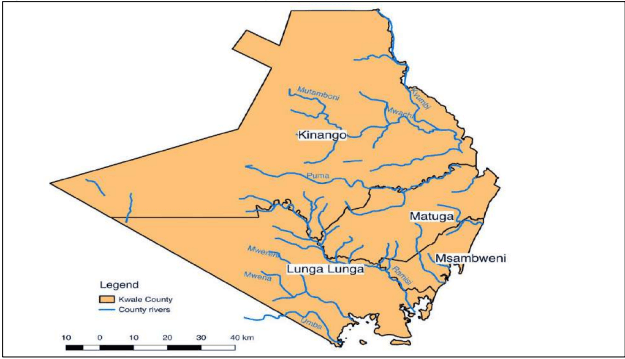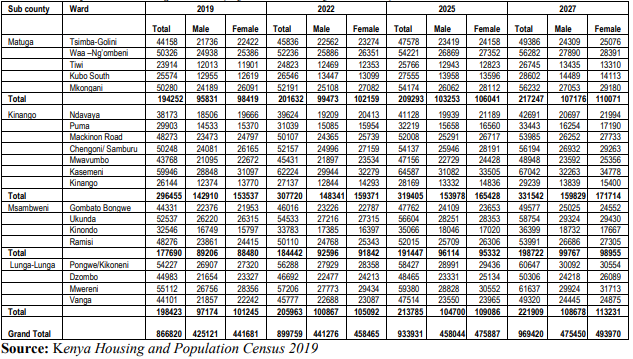Kwale County is one of the 47 counties, and its capital is Kwale, although Ukunda is the largest town. Kwale County has an estimated population of 649,931. Kwale is mainly an inland county, but it has a coastline south of Mombasa. Diani Beach is part of the Msambweni division. Shimba Hills and Mwaluganje Sanctuary are other attractions in the county. The county has four constituencies: Msambweni, Matuga, Kinango, and Lungalunga. The main ethnic communities in the county include the Digo and Duruma clans of the larger Mijikenda tribe and a significant presence of the Kamba tribe. The Digos are the majority in Msambweni, Lungalunga, and Matuga while the Durumas are the dominant in Kinango. Most Kambas are found in Kinango, Matuga, and Lungalunga with a significant population in Msambweni.

The coastline in Kwale County stretches for roughly 250 kilometers, which consists of corals, sands, and alluvial deposits. The Coastal Plain, the Foot Plateau, the Coastal Uplands, and the Nyika Plateau are the four principal geographical features of Kwale County. On the western boundary of the county, the Nyika Plateau (commonly referred to as the “hinterland”) gently climbs from roughly 180 meters and covers more than half of the county. A basement rocks system lies beneath the plateau, which also contains random reddish sand soil patches. Since the soil in this region is semi-arid and low-fertile, livestock rearing became the main activity in the hinterland. Seven major rivers and numerous minor streams form the county’s drainage system. The main rivers and streams are Ramisi, Marere, Pemba, Mkurumuji, Umba, Mwachema and the Mwachi River. Out of these seven rivers, three are permanent (Marere, Mwaluganje, and the Ramisi River). All these rivers flow into the Indian Ocean
Administrative units
Kwale is a multi-ethnic county that is predominantly occupied by the Digo and Duruma as the majority ethnic groups. Other ethnic groups living in the County are Kamba, Washirazi, Wapemba, Makonde, as well as other Kenyan ethnic groups. Included, are also Europeans, Asians and noncitizens who are a minority. Kwale County is administered as shown in the table.

Population Projections (By Sub County and Sex)
The County population projections for 2022 to 2027 is based on the 2019 Kenya Housing and Population Census by age cohort and gender as presented in table 5 below. Out of the County total population, 112,152 (1.7 per cent) are persons living with disability (PLWDs). Youth constitute 33.0 per cent (286,051) of the population of whom 53.0 per cent (151607) are female
Economy
Kwale County like every coastal town, fishing is one of the historical economic activities. With time, the town has slowly been transforming from a fishing village to a basic industrial and service provision town. Cashew nuts, sugarcane, cotton, simsim, bixa, and tobacco are cultivated as cash crops with specific regions doing livestock farming.
Health
The County has a total of three (3) government hospitals, eight health centers, and sixty- four (64) dispensaries located in Msambweni, Kwale, and Kinango constituencies. The doctor and nurse population ratio stand at 1: 76,741 and 1: 3,133 respectively. In addition, the county has two (2) private hospitals both located in Diani town. The average distance to the nearest health facility within the County is seven (7) kilometers as compared to the required maximum of three (3)
The use of contraception(any FP method) among the county’s married women is at a rate of 35% (KDHS 2022) is considerably below the National rate of 63% (KDHS2022). The unmet need for family planning (15-49 years) is 24.4%, which is higher than the National rate of 14%. Among the same cohort, use of modern contraceptives is at 35%, compared to 57% at national level (KDHS 2022). Early child bearing among adolescents (15-19 years) has been attributed to early marriages, the high unmet need for contraception and poor access to FP services. Teenage pregnancies in the County is at 15% (KDHS2022) which is equivalent to the National rate of 15%. This is a significant drop from 24% (Kwale County) and 18% (Nationally) (KDHS2014). Skilled birth deliveries at 89%, women who have experienced sexual violence is at 4% while physical violence is at 13%.


